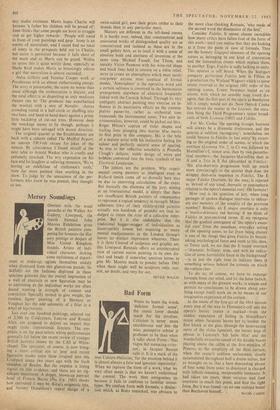Bad Form
Consider Fidelio. It stems almost incredible how many critics have fallen foul of the form of this work—until you realise that they are looking at it from the point of view of formula. They see the homely Singspiel elements of the opening scenes as belonging to one kind of convention and the tremendous events which replace them, to another. Ergo, Fidelio is sadly lacking in unity. This opinion is still heard. When the Stuttgart company performed Fidelio here in Fifties in a production (by Wieland Wagner) which to some extent .reverted to the original 1805 order of the opening scenes, Ernest Newman stated as art axiom, with which no sensible man could dis- agree, that the first part of the opera as Beethoven left it simply would not do. Now Deryck Cooke has revived the matter in the Listener, the occa- sion being the Third Programme's recent broad- casts of both Leonora (1805) and Fidelio.
For Mr. Cooke `the opening triangle business will always be a dramatic irrelevance, and the quartet a sublime incongruity'; nonetheless we could 'restore to Fidelio its lost unity' by revert- ing to the original order of scenes, in which the overture (Leonora No. 2, in C) was followed by Marzelline's C minor aria,.then by two parenthe- tical numbers—the Jacquino-Marzelline duet in A and a Trio in E flat (discarded in Fidelio): `this aria-duet-trio progression built up much more convincingly to the quartet than does the scrappy duet-aria sequence in Fidelio'. The E major Fidelio Overture, 'by the way, is rejected as 'devoid of any tonal, thematic or atmospheric relation to the opera's essential core'. Oh formula!
How real is the question of key, when long passages of spoken dialogue intervene to obliter- ate our memory of the tonality of the previous number? Besides, an E major overture is only a `musico-dramatic red herring' if we think of Fidelio in preconceived terms. If we recognise that the gradual emergence of `the opera's essen- tial core' from the mundane, everyday setting of the opening scene, so far from being clumsy is one of the things that gives Fidelio its breath- taking psychological force and truth to life, then, as Tovey said, we see that the E major overture =dramatic, brilliant, terse, and with an indica- tion of some formidable force in the background' —is in just the right tone to indicate there is something serious behind the comedy on which the curtain rises.
To do so, of course, we have to expunge formula from our mind, and let the form (which, as with many of the greatest works, is unique and permits no conclusions to be drawn about any- thing except itself) work on us by means of our imaginative experience of the content.
In the music of the first act of the 1814 version every step of the way to Florestan's cell and the opera's heroic centre is marked—from the sudden expansion of feeling in Marzelline's music when Jacquino leaves her to answer the first knock at the gate, through the heart-easing entry of the violas (quartet), the heroic leap of phrase in Leonore's `Ich babe Mut' and the wonderfully evocative sound of the double basses playing above the cellos at the first• mention of Pizarro, to the simplicity of the final curtain, when the music's sublime seriousness, slowly accumulated throughout half a dozen scenes, has so wrought on us that a bare descending phrase of four notes from tonic to dominant is charged with infinite meaning, inexpressible humanity. It had taken ten years, three versions and four overtures to reach this point, and find the right form. But it was found—as no one realised better


































 Previous page
Previous page